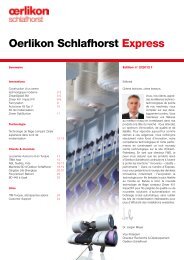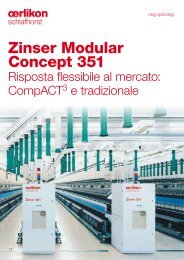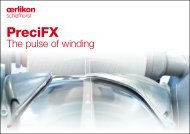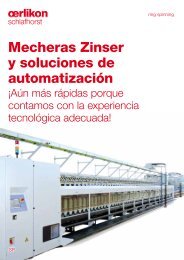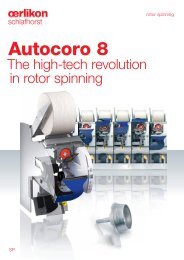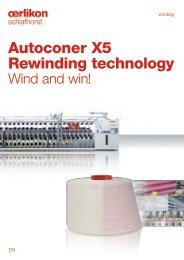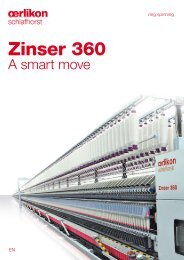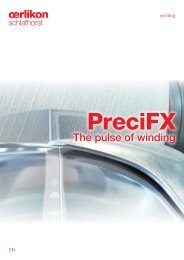Oerlikon Schlafhorst Express - Oerlikon Schlafhorst - Oerlikon Textile
Oerlikon Schlafhorst Express - Oerlikon Schlafhorst - Oerlikon Textile
Oerlikon Schlafhorst Express - Oerlikon Schlafhorst - Oerlikon Textile
Create successful ePaper yourself
Turn your PDF publications into a flip-book with our unique Google optimized e-Paper software.
8<br />
<strong>Oerlikon</strong> <strong>Schlafhorst</strong> <strong>Express</strong><br />
Corolab XQ/XF –<br />
the yarn clearing system with a future<br />
Simple – Compact - Precise<br />
Yarn faults are a topic that those in the textile business have lived<br />
with for generations. Possible complaints about wovens and knits<br />
arising from these can become a high cost factor for any company<br />
- costs that are a thing of the past thanks to the Corolab XQ/XF<br />
sensor system.<br />
The Corolab XQ/XF sensor system comprises digital sensor technology<br />
that is integrated into every spinning unit on the Autocoro rotor spinning<br />
machine. Current clearing information is displayed on the operating<br />
and display unit belonging to the system. Receiving the clearing<br />
settings requested individually by the user and communicating these<br />
to the individual sensors is one of the tasks of this unit.<br />
To make the settings easy and compact for the user, <strong>Oerlikon</strong><br />
<strong>Schlafhorst</strong> has developed a matrix system for Corolab XQ/XF that<br />
can be used universally for the individual yarn clearing sections. This<br />
matrix principle is also used for classifying and displaying the yarn<br />
faults. The clearing setting and clearing result are accessible to the<br />
user at a glance. The clearing parameters can be saved easily in the<br />
article memory and are thus always available for later applications.<br />
Matrices of the Corolab XQ/XF:<br />
• Short fault matrix for the areas thick places,<br />
thin places and faults appearing in bulk<br />
• Long fault matrix for the areas of sliver defects<br />
and yarn count faults<br />
• Foreign fibre matrix for the area of foreign fibres<br />
Defining the clearing limits for the short fault and long fault matrices<br />
is generally based on the criteria yarn fault length [mm] and yarn<br />
diameter deviation [%], for the foreign fibre matrix on the criteria<br />
foreign fibre length [mm] and brightness deviation [%]. The level of<br />
clearing is determined precisely by activating individual matrix classes.<br />
Short fault matrix<br />
The short fault matrix is divided into the thick place and thin place<br />
range. Cleared faults as well as faults remaining in the yarn are<br />
recorded in the individual matrix classes. Short, consecutive thick<br />
places appearing in bulk can be cleared precisely by additionally<br />
activated matrix fields.<br />
Long fault matrix<br />
Innovations<br />
The long fault matrix is divided into the areas sliver defects and yarn<br />
count faults. Sliver defects, which cause yarn faults up to 10 m in<br />
length with a positive or negative yarn diameter deviation, are detected<br />
in the ranges sliver thick and sliver thin and cleared. Yarn count<br />
faults, which cause yarn faults up to 10 m in length with a positive or<br />
negative yarn diameter deviation, are detected in the ranges yarn<br />
count thick and yarn count thin and cleared.



